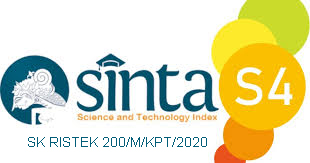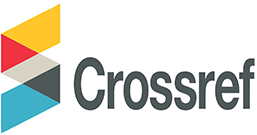Implementation of the K-Means Clustering Algorithm in Determining Productive Oil Palm Blocks at Pt Arta Prigel
Abstract
The purpose of this study is to implement the K-Means Clustering method to determine the patterns of productive oil palm production based on their blocks at Pt Arta Prigel. The research is motivated by issues within the oil palm blocks, such as the absence of productive block summaries, insufficient plantation land analysis, and erroneous decision-making. The development method utilizes CRISP-DM, with data spanning 2 years from October 2021 to October 2023. From the 1275 production records, after cleaning, 1015 records remain. Filtering the initial 51 blocks results in 37 blocks for the years 2021 and 2022, and 46 blocks for the year 2023. After clustering, the production outcomes for the year 2021 are as follows: cluster_0 has 34 blocks, cluster_1 has 10 blocks. For the year 2022, cluster_0 has 24 blocks, cluster_1 has 37 blocks. In the year 2023, cluster_0 has 44 blocks, cluster_1 has 27 blocks. The testing method employs the silhouette coefficient, and the silhouette score testing results indicate the formation of 2 clusters (K=2) with a value of 0.62, the results obtained from testing with 2 clusters indicate that the formed clusters are accurate. The findings of this study include patterns, graphs, and production tables generated using the K-Means Clustering method at Pt Arta Prigel.
Keywords
Full Text:
PDFReferences
P. Amita Tri Prasasti and C. Dewi, “Pengembangan Assesment of Inovation Learning Berbasis Revolusi Industri 4.0. untuk Guru Sekolah Dasar,” J. Ilm. Sekol. Dasar, vol. 4, no. 1, p. 66, 2020, doi: 10.23887/jisd.v4i1.24280.
R. T. Aldisa, P. Maulana, and M. A. Abdullah, “Penerapan Big Data Analytic Terhadap Strategi Pemasaran Job Portal di Indonesia dengan Karakteristik Big Data 5V,” vol. 3, pp. 267–272, 2022, doi: 10.30865/json.v3i3.3905.
U. Dirgantara and M. 2022 Suryadarma, “Revolusi Industri 4.0: Big Data, Implementasi Pada Berbagai Sektor Industri (Bagian 2),” no. Bagian 2.
R. I. O. Limabri, F. Putrawansyah, and A. Arif, “Penerapan Data Mining Untuk Mengklasifikasi Nasabah Bank Sumsel Babel Menggunakan Algoritma C4. 5,” Escaf, pp. 1101–1108, 2023.
P. Alkhairi and A. P. Windarto, “Penerapan K-Means Cluster Pada Daerah Potensi Pertanian Karet Produktif di Sumatera Utara,” pp. 762–767, 2019.
& Z. 2021 Zulfa, Auliya, Permata, “Analisis Data Mining Untuk Clustering Kasus COVID-19 di Provinsi Lampung Dengan Algoritma K-Means,” vol. 2, no. 2, pp. 100–108, 2021.
F. Febriansyah and S. Muntari, “Penerapan Algoritma K-Means untuk Klasterisasi Penduduk Miskin pada Kota Pagar Alam,” vol. 8, no. 1, pp. 66–77, 2023.
M. R. Nahjan, N. Heryana, A. Voutama, F. I. Komputer, U. S. Karawang, and R. Miner, “Implementasi Rapidminer Dengan Metode Clustering K-Means Untuk Analisa Penjualan Pada Toko Oj Cell,” vol. 7, no. 1, pp. 101–104, 2023.
N. Dwitri, J. A. Tampubolon, S. Prayoga, and P. P. P. A. N. W. F. I. R. H. Zer, “Penerapan Algoritma K-Means Dalam Menentukan Tingkat Penyebaran Pandemi Covid-19 Di Indonesia,” vol. 4, no. 1, pp. 128–132, 2020.
R. Supardi and I. Kanedi, “Implementasi Metode Algoritma K-Means Clustering Pada Toko Eidelweis,” vol. 4, no. 2, pp. 270–277, 2020.
S. Rokhanah, A. Hermawan, and D. Avianto, “Pengaruh Principal Component Analysis Pada Naïve Bayes dan K-Nearest Neighbor Untuk Prediksi Dini Diabetes Melitus Menggunakan Rapidminer,” vol. 11, no. 1, 2023.
M. Astiningrum, M. Mentari, and Y. G. Maranatha, “Mutu Buah Salak Menggunakan Pengolahan Citra Digital,” pp. 205–210.
N. Afdhaliah, “Perbandingan kinerja algoritma ward dan algoritma k-means dengan uji silhouette coefficient,” 2020.
F. N. Dhewayani, D. Amelia, D. N. Alifah, B. N. Sari, and M. Jajuli, “Implementasi K-Means Clustering untuk Pengelompokkan Daerah Rawan Bencana Kebakaran Menggunakan Model CRISP-DM,” vol. 12, no. 1, pp. 64–77, 2022, doi: 10.34010/jati.v12i1.6674.
M. A. Hasanah, S. Soim, and A. S. Handayani, “Implementasi CRISP-DM Model Menggunakan Metode Decision Tree dengan Algoritma CART untuk Prediksi Curah Hujan Berpotensi Banjir,” vol. 5, no. 2, 2021.
DOI: https://doi.org/10.31326/jisa.v7i1.2008
Refbacks
- There are currently no refbacks.
Copyright (c) 2024 Yesi Pitaloka Anggriani,Alfis Arif, Febriansyah

This work is licensed under a Creative Commons Attribution-ShareAlike 4.0 International License.
JOURNAL IDENTITY
Journal Name: JISA (Jurnal Informatika dan Sains)
e-ISSN: 2614-8404, p-ISSN: 2776-3234
Publisher: Program Studi Teknik Informatika Universitas Trilogi
Publication Schedule: June and December
Language: Indonesia & English
APC: The Journal Charges Fees for Publishing
Indexing: EBSCO , DOAJ, Google Scholar, Arsip Relawan Jurnal Indonesia, Directory of Research Journals Indexing, Index Copernicus International, PKP Index, Science and Technology Index (SINTA, S4) , Garuda Index
OAI address: http://trilogi.ac.id/journal/ks/index.php/JISA/oai
Contact: jisa@trilogi.ac.id
Sponsored by: DOI – Digital Object Identifier Crossref, Universitas Trilogi
In Collaboration With: Indonesian Artificial Intelligent Ecosystem(IAIE), Relawan Jurnal Indonesia, Jurnal Teknologi dan Sistem Komputer (JTSiskom)
JISA (Jurnal Informatika dan Sains) is Published by Program Studi Teknik Informatika, Universitas Trilogi under Creative Commons Attribution-ShareAlike 4.0 International License.


















